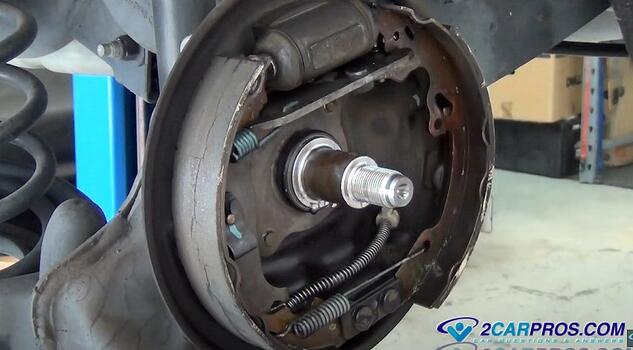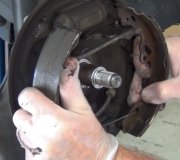Brake shoes are used on the rear of your vehicle and provide about 35% of the brake power when coming to stop and over time the brake shoes will wear out and can cause various issues. This guide provides a detailed step-by-step process to identify the symptoms of bad automotive brake shoes.
History
Some vehicles are equipped with a brake system that is called a disc-drum set up which refers to the style of brakes on the front and rear of the vehicle. On this style of brake systems the job of the emergency brake is done by the rear brake shoes. Rear drum brakes have been the standard for many years in the automotive industry and generally cost less to produce than disc brake systems, but are less efficient than their counterpart, rear disc brakes. This is why there are featured on the rear of the vehicle only.
How Brake Shoes Work
There are four brake shoes per car, two on each side, right and left. These shoes are forced against the rotating brake drum via the brake system to slow the car down in a braking event. Friction material is mounted to the metal frame of the brake shoe and it what wears out as the car is driven. The activation of the emergency brake uses the same principle of forcing the shoes outward against the drum helping to hold the car in place. Vehicles with rear disc brakes will use a smaller drum brake in the center of the rotor for the emergency brake.
What Goes Wrong?
Under normal driving conditions friction between the shoe and drum will remove the brake material from the shoe. When the brake material wears beyond its limits the brake pedal will travel further downward than it should which gives the felling the brakes are not working as well. In general, if a vehicle's parking brake doesn't hold or the brake pedal travels to the end of its throw the rear brake shoes need to be checked for replacement.
Fluid contamination is an issue for brake shoes, so if a wheel cylinder or rear axle seal starts to leak it can soak the brake show lining making the shoes grab and lock up. It seems strange that oil and brake fluid would make the brakes lock up because one would think it could allow the brakes to slip and slide making their action even less but this is not the case.
Rear drum brakes have a tendency to grab and lock-up even without the introduction of brake fluid or gear oil. This is due to over worn shoes contacting too much surface area inside the drum. Locking up can be due to the brake shoe being "sprung" which allows the very top and bottom of the shoe to contact the drum. The center of the shoe should be the only part that contacts the drum.
Recognizing Common Symptoms
- Grinding or squeaking noise from the rear when the brake are applied, this noise is caused by the metal contacting the drum.
- Poor braking performance can be a sign of worn out brake shoes.
- A dragging feeling when driving could indicate that the brake shoe lining has come off of the shoe and is stuck between the shoe frame and drum.
- If the parking brake handle or foot actuator goes to it's full travel without tightening this can be worn out brake shoes.
Performing a Visual Inspection
If you are unsure of the brake shoe condition it is best to remove the tire and then the brake drum to inspect the shoe linings directly. Check the thickness of the friction material. If it's less than 1/8 inch (3 mm), it's time to replace the brake shoes. Also, inspect the surface of the brake shoes for cracks, glazing, or contamination with oil or grease. Please follow this guide for more information - Brake shoe replacement guide
How Much Does It Cost?
When replacing your brake shoes and drums cost is always at the back of our minds. New OEM (Original Equipment Manufacturer) shoes are made of better material and will outperform cheaper brakes over the long run. Another difference in shoes will be how the friction material is attached to the shoe frame or metal backing. There are generally two methods which are used; bonded (glued) or riveted. Smaller shoes tend to be bonded while larger shoes tend to be riveted.
The size of the shoe greatly determines the cost for example; a smaller shoe set for a compact car can cost between $19.00 and $48.00, while larger shoe sets can cost between $85.00 and $165.00. Drums will typically cost between $26.00 and $85.00 (US). If you are having the job done at a local garage or dealership it can run between $320.00 and $560.00 (US). You can see the price difference between having it done, and doing it yourself is quite substantial. On older vehicles and spring hardware kit can also be purchased which runs about $25.00 (US).
How Long Do Brake Shoes Last?
Brake shoes tend to last about twice as long as the front pads due to the car's brake bias (front to rear ratio). You can expect the shoes and drum to last between 40,000 and 60,000 miles depending on driving habits and the design of the brake system.
Should I Adjust My Brake Shoes?
Drum brakes incorporate an automatic adjusting mechanism, but sometimes it may not work as intended and become frozen do to the extreme heat or moisture they endure over normal usage. Some vehicles have a window or slot in the backing plate where you can access the adjuster to manually adjust the brakes. If no access slot is visible the wheel and drum must be removed to adjust the shoes.
Watch the Video!
Please watch this video of the job being done to glean additional helpful information.
Credits
This guide knowledge base was created by the 2CarPros Team, and by Ken Lavacot: Automobile repair shop owner and certified master automobile technician of over 30 years. If you have question or need help please ask one of our experts we are happy to help. Please visit our 2CarPros YouTube Channel for additional car repairs.




